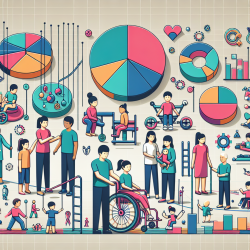The recently published study, "Assessment of Chinese Rehabilitation Assistance System for Disabled Children," provides crucial insights into the rehabilitation landscape for disabled children in China. By analyzing data from 1,698 disabled children across 243 designated rehabilitation institutions in Hu'nan Province, the research offers actionable outcomes for practitioners aiming to improve their rehabilitation practices.
Key findings from the study include:
- Generational Differences: Rehabilitation effects vary significantly across different age groups, with children aged 3-6 showing the highest improvement, followed by those aged 6-14. Children aged 0-3 exhibited the least improvement, highlighting the need for age-specific interventions.
- Support Systems: Government support, institutional support, and family support all play critical roles in enhancing rehabilitation outcomes. However, institutional support has the most substantial direct effect, followed by family and government support.
- Mediating Role of Institutions: Institutional support serves as a partial mediator between government/family support and rehabilitation outcomes, indicating that strengthening institutional capacities can amplify the benefits of other support forms.
For practitioners, these findings suggest several actionable strategies:
1. Age-Specific Interventions
Given the generational differences in rehabilitation outcomes, practitioners should tailor interventions to meet the specific needs of different age groups. For instance, early intervention programs for children aged 0-3 should focus on foundational skills, while programs for older children can incorporate more specialized therapies.
2. Strengthening Institutional Support
Institutions play a pivotal role in rehabilitation outcomes. Enhancing the professional quality, completeness, and adaptability of rehabilitation environments can significantly improve results. This includes investing in advanced rehabilitation techniques and comprehensive training for rehabilitation personnel.
3. Leveraging Family Support
Families are crucial in the rehabilitation process. Practitioners should work closely with families to ensure they are well-informed and confident in their roles. Providing resources and training for at-home rehabilitation activities can help sustain progress made in institutional settings.
4. Enhancing Government Support
Government policies and funding are foundational to the rehabilitation system. Practitioners should advocate for more targeted and inclusive policies that address the diverse needs of disabled children. This includes simplifying application procedures and increasing public awareness of available support.
By implementing these strategies, practitioners can enhance rehabilitation outcomes for disabled children, contributing to their overall well-being and integration into society. For a more detailed understanding, practitioners are encouraged to read the original research paper.
To read the original research paper, please follow this link: Assessment of Chinese rehabilitation assistance system for disabled children.










